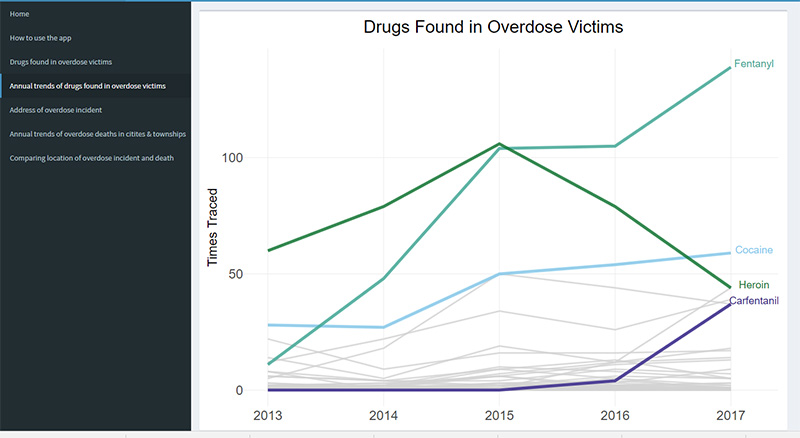

Student-developed web app explores overdose deaths in Butler County

John Bailer and his students developed a web app for the Butler County Coroner's office to track trends in drug overdoses.
A new interactive web app promises to become an important component in battling the opioid crisis in Butler County by exploring the patterns of overdose deaths.
Using data from
These details include the types of drugs found in the lab testing of overdose victims, the demographic profiles of victims and data about where the overdoses and deaths occurred.
For instance, yearly data on trends of drugs found in overdose victims show that fentanyl climbed substantially from 2013 to 2015, and then from 2016 to 2017 (see chart above).
More than 80 percent of Butler County overdose deaths during this time period were associated with opioids, according to the Butler County Coroner’s office.
According to Butler County Coroner Lisa Mannix, the app is intended to make it easier for law enforcement agencies, emergency responders
“It is my goal to help reduce the number of fatal drug overdoses in Butler County, and this web app can be vital to achieving that goal,” said Mannix. “The more information made readily available, the easier it will be for our partners in the community to target those regions that need the assistance the most.”
The web app is available at dataviz.miamioh.edu/Butler_County_Overdose_Deaths and is accessible to the public.
John Bailer is University Distinguished Professor and chair of Miami’s department of statistics. He also is a member of the steering committee for the Center for Analytics and Data Sciences at Miami. The center provides a collaborative research space to develop real solutions for business and other organizations that partner with the university.
Bailer said his class was asked by the coroner to develop tools to explore the overdose death data. In the fall of 2017, multiple student teams worked on this project and presented their work at the end of the semester.
“While this was a great start, additional development was needed before this web app was ready for general sharing,” he said.
Bri Clements
Bri Clements, a student in the data visualization class, worked on an independent study project this spring to do this finish work on the app that she and her classmate, Katherine Shockey, had developed. Both are majoring in statistics and analytics.
Clements explained the work she did on the project not only improved her coding skills, but it also gave her the opportunity to learn how to better communicate with clients, understand their wants and incorporate their feedback.
“I learned a great deal from this project, and it was a great pleasure to work on a nationwide issue that has especially impacted my local community,” she said.
Updating and maintaining the web app will be coordinated by Bailer, who will recruit students to participate. He explained that Clements added general code to allow for relatively easy incorporation of 2018 and 2019 data.
“We hope that this will help to communicate the impact and features of this epidemic,” Bailer said.
Written by Carole Johnson, university news and communications, and Heather Johnston, office for the advancement of research and scholarship
